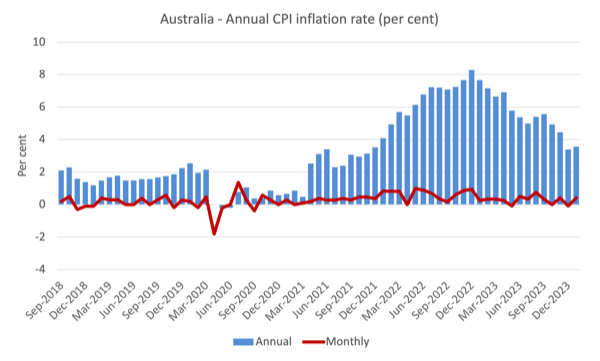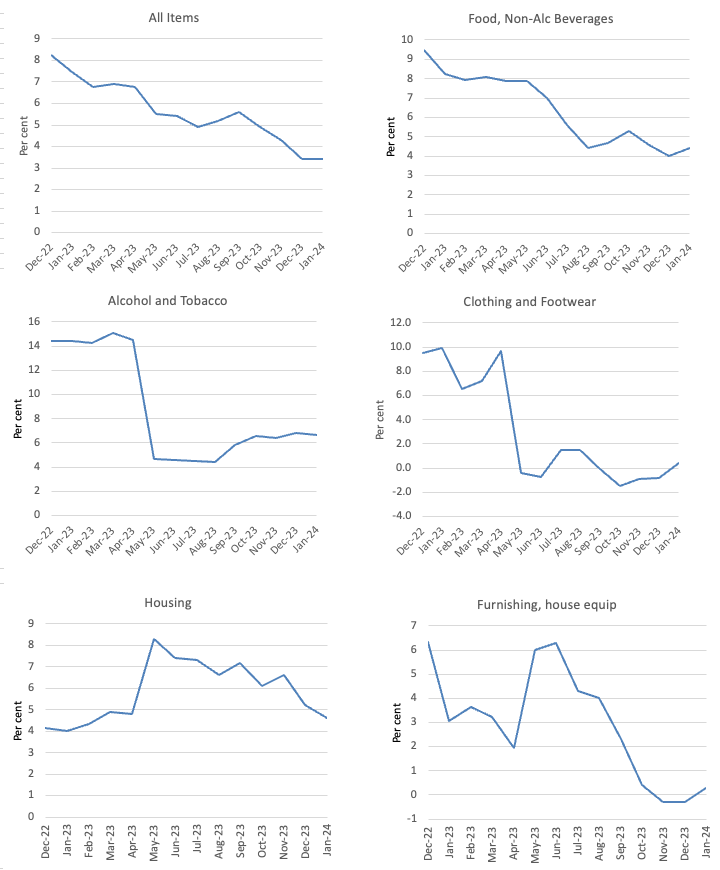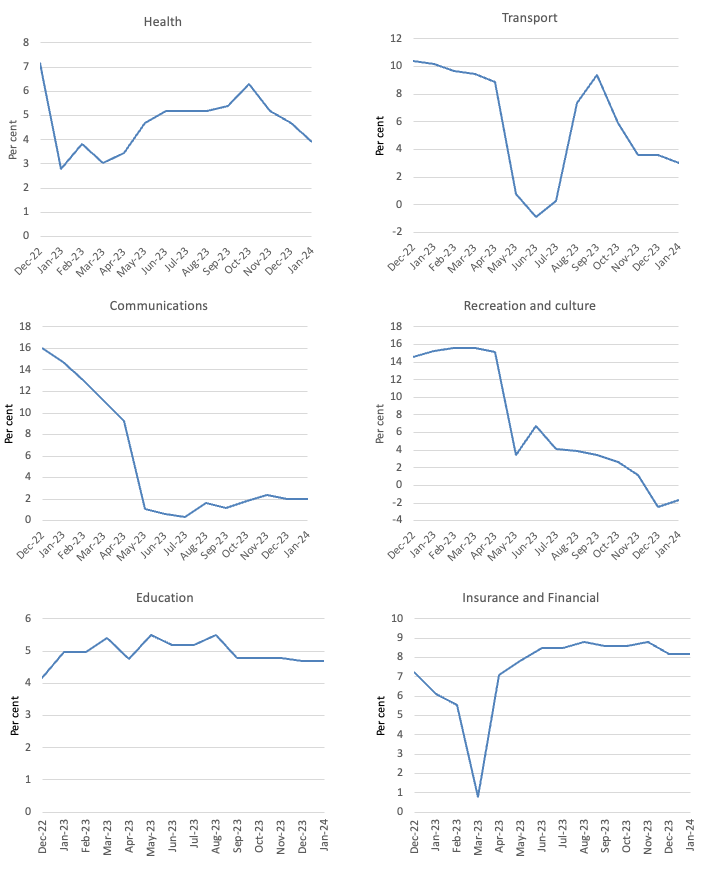[ad_1]
At this time (February 28, 2024), the Australian Bureau of Statistics (ABS) launched the most recent – Month-to-month Client Value Index Indicator – for January 2024, which confirmed that the inflation charge steadied at 3.4 per cent however stays in a downward trajectory in Australia as it’s elsewhere on the planet. At this time’s figures are the closest now we have to what’s truly occurring for the time being and present that the inflation was 3.4 per cent in January 2024 however most of the key driving elements at the moment are firmly declining. The trajectory is firmly downwards. As I present beneath, the one elements of the CPI which can be rising are both attributable to exterior elements that the RBA has no management over and are ephemeral, or, are being brought on by the RBA charge rises themselves. All the speed hikes have executed is engineer an enormous shift in earnings distribution in the direction of the wealthy away from the poor. The slowdown the Australian financial system is experiencing is basically attributable to fiscal drag not greater rates of interest.
The newest month-to-month ABS CPI knowledge exhibits for January 2024 that:
- The All teams CPI measure was regular at 3.4 per cent.
- Meals and non-alcoholic drinks rose by 4.4 per cent (4 per cent in December).
- Clothes and footwear 0.4 per cent (-0.8 per cent in December).
- Housing 4.6 per cent (5.2 per cent in December).
- Furnishings and family tools 0.3 per cent (-0.3 per cent in December).
- Well being 3.9 per cent (4.7 per cent in December).
- Transport 3 per cent (3.6 per cent in December).
- Communications 2 per cent (2 per cent in December).
- Recreation and tradition -1.7 per cent (-2.4 per cent in December).
- Training 4.7 per cent (4.7 per cent in December).
- Insurance coverage and monetary providers regular at 8.2 per cent.
The ABS Media Launch (February 28, 2024) – Month-to-month CPI indicator rose 3.4 per cent within the 12 months to January 2024 – famous that:
The month-to-month Client Value Index (CPI) indicator rose 3.4 per cent within the 12 months to January 2024 …
Annual inflation for the month-to-month CPI indicator was regular at 3.4 per cent and stays the bottom annual inflation since November 2021 …
Probably the most vital contributors to the January annual improve have been Housing (+4.6 per cent), Meals and non-alcoholic drinks (+4.4 per cent), Alcohol and tobacco (+6.7 per cent) and Insurance coverage and monetary providers (+8.2 per cent). Partially offsetting the annual improve is Recreation and tradition (-1.7 per cent) primarily attributable to Vacation journey and lodging (-7.1 per cent) …
Lease costs rose 7.4 per cent within the 12 months to January, reflecting a good rental market and low emptiness charges throughout the nation …
Annual electrical energy costs rose 0.8 per cent within the 12 months to January 2024. The introduction of the Vitality Invoice Aid Fund rebates for eligible households from July 2023 has principally offset electrical energy value rises from annual value critiques in July attributable to will increase in wholesale costs.
So a couple of observations:
1. The inflation scenario has stabilised and can proceed to say no over the subsequent a number of months.
2. Housing inflation has fallen from 5.2 per cent in December to 4.6 per cent in January with hire inflation nonetheless an issue.
3. The hire inflation is partly as a result of RBA’s personal charge hikes as landlords in a good housing market simply go on the upper borrowing prices – so the so-called inflation-fighting charge hikes are literally driving inflation.
4. Notice that fiscal coverage measures with respect to electrical energy costs has successfully eradicated that stress.
The Federal authorities may have executed rather more to alleviate the stress on households of those non permanent cost-of-living rises over the past two years.
Notice the rise in FIRE providers which is, partly, as a result of banks gouging income.
The final conclusion is that the worldwide elements that have been liable for the inflation pressures are abating pretty rapidly because the world adapts to Covid, Ukraine and OPEC revenue gouging.
The subsequent graph exhibits, the annual charge of inflation is heading in a single path – down with month-to-month variations reflecting particular occasions or changes (reminiscent of, annual indexing preparations and many others).
The blue columns present the annual charge whereas the crimson line exhibits the month-to-month actions within the All Gadgets CPI.
The subsequent graphs present the actions between December 2022 and January 2024 for the principle elements of the All Gadgets CPI.
Typically, most elements are seeing dramatic reductions in value rises as famous above and the exceptions don’t present the RBA with any justification for additional rate of interest rises.
For instance, the Recreation and Tradition part that was driving inflation in 2023 is now deflating – this simply mirrored the non permanent bounceback of journey and associated actions after the in depth lockdowns and different restrictions within the early years of the Pandemic.
It was all the time going to regulate again to extra normal behaviour.
General, the inflation charge is declining as the provision elements ease.
The meals part can be delicate to the behaviour of the supermarkets.
Simply yesterday, it was reported that value gouging within the retail sector supplying meals and groceries was delivering huge revenue margins.
The ABC information story (February 27, 2024) – Coles accused of gouging customers as they wrestle to place meals on the desk – reported that the Coles Group, one in every of two main grocery store corporations in Australia that management round 64 per cent of the whole market in Australia, with Aldi coming in round 10 per cent, posted one other huge revenue outcome for the 6 months to December 2023.
The gross revenue margin for Coles and Woolworths is round 26 to 27 per cent, which for corporations that present meals (a steady commodity) is ridiculously excessive.
The margin has risen for Coles over the inflationary interval, which is prima facie proof of revenue gouging.
The corporate claimed that:
Our income permit us to proceed to spend money on our enterprise and ship for our stakeholders — whether or not they’re our clients, suppliers, crew members, neighborhood companions or shareholders — we’re working laborious to ship good outcomes throughout the board.
However the proof is that there’s extra return to shareholders and fewer funding occurring and likewise squeezing of their suppliers is frequent.
Additional, making an attempt to assert that the form of returns they’ve been producing are good for his or her “clients” (which is absolutely stretching the that means of “stakeholders”) is disengenous within the excessive.
The purpose is that if these two dominant corporations – which successfully kind a oligopoly – had much less discretion to push up revenue margins underneath the duvet of normal value pressures within the financial system, then the CPI inflation charge could be a lot decrease than it presently is.
That has nothing to do with wages or extreme demand pressures and all to do with extreme focus within the sector which must be extra intently regulated.
The asymmetry of financial coverage
Economists who assist using rates of interest to change spending ranges within the financial system (which suggests most economists) have argued that the declining inflation is the direct results of the RBA’s rate of interest hikes.
They level to the slowdown in GDP progress and the declining retail gross sales figures as proof to assist their competition.
Nonetheless, they ignore the truth that fiscal coverage has shifted from producing deficits to surpluses over the past 12 months.
Throughout the GFC, the Australian Treasury carried out analysis to estimate the relative contributions of financial and monetary coverage to the modest restoration in GDP after the large international monetary shock that we imported.
The RBA had minimize charges whereas the Treasury had overseen a serious improve within the fiscal deficit on account of a number of discretionary spending initiatives by the Federal authorities.
Within the first 4 quarters of the GFC (December-quarter on), they estimated that the fiscal stimulus had contributed considerably to the quarterly progress charge.
On December 8, 2009 the Federal Treasury made a presentation entitled – The Return of Fiscal Coverage – to the Australian Enterprise Economists Annual Forecasting Convention 2009.
I wrote about that on this weblog put up – Lesson for immediately: the general public sector saved us (December 21, 2009).
Whereas I disagree with many of the theorising introduced by the Treasury within the paper, the graphs they offered have been attention-grabbing.
They famous:
Chart 10 exhibits Treasury’s estimates … of the impact of the discretionary fiscal stimulus packages on quarterly GDP progress. These estimates recommend that discretionary fiscal motion offered substantial assist to home financial progress in every quarter over the 12 months to the September quarter 2009 – with its maximal impact within the June quarter …
The estimates suggest that, absent the discretionary fiscal packages, actual GDP would have contracted not solely within the December quarter 2008 (which it did), but in addition within the March and June quarters of 2009, and due to this fact that the financial system would have contracted considerably over the 12 months to June 2009, quite than increasing by an estimated 0.6 per cent.
Whereas many economists on the time claimed there was no want for any fiscal response, it’s apparent that Australia would have been in a 3-quarter recession if the intervention had not have occurred.
The opposite attention-grabbing a part of their work was the estimates of the affect of the fast discount in rates of interest by the Reserve Financial institution on GDP progress charges
This evaluation offered a direct comparability between expansionary fiscal coverage and loosening of financial coverage.
The conclusion was clear:
… this fall in actual borrowing charges would have contributed lower than 1 per cent to GDP progress over the 12 months to the September quarter 2009, in contrast with the estimated contribution from the discretionary fiscal packages of about 2.4 per cent over the identical interval.
So discretionary fiscal coverage modifications was estimated to be round 2.4 occasions more practical than financial coverage modifications (which have been of report proportions).
Take into consideration now.
Rates of interest have been hiked 11 occasions since Might 2022.
However on the identical time, the fiscal steadiness has shifted from a deficit of 6.4 per cent of GDP in 2020-21 and a deficit of 1.4 per cent of GDP in 2021-22, to a surplus of 0.9 per cent of GDP in 2022-23.
The Federal authorities is projecting one other surplus within the present monetary 12 months.
That may be a main fiscal shift and the fiscal drag explains many of the slowdown in progress and expenditure.
However there may be an asymmetry additionally working in financial coverage, which pertains to the spending propensities of the completely different earnings teams which can be affected by rate of interest modifications.
Excessive earnings teams have decrease marginal propensities to devour (that means they save extra per further greenback of disposable earnings) than low earnings households.
Additionally they have extra monetary wealth.
When rates of interest rise, complete spending by low earnings households doesn’t change a lot as a result of they’re already spending all their earnings.
Solely the composition modifications.
Additionally they personal little or no monetary wealth so don’t get any earnings boosts by way of the rising returns.
For top earnings households, they achieve an enormous increase in earnings from their monetary belongings and though they save greater than low earnings households, their spending will increase considerably by way of the wealth impact.
These modifications don’t function in reverse.
So, it’s more likely that slowdown in GDP is the results of the fiscal drag quite than the rate of interest will increase.
Conclusion
The newest CPI knowledge demonstrates that inflation is now contained and in a downward trajectory in Australia as it’s elsewhere on the planet.
The explanation for the decline is straightforward – the elements that have been driving the inflation are abating.
And people elements – provide constraints, shock from Russian invasion, OPEC value gouging – weren’t delicate to RBA charge hikes.
All the speed hikes have executed is engineer an enormous shift in earnings distribution in the direction of the wealthy away from the poor.
The slowdown the Australian financial system is experiencing is basically attributable to fiscal drag not greater rates of interest.
That’s sufficient for immediately!
(c) Copyright 2024 William Mitchell. All Rights Reserved.
[ad_2]


